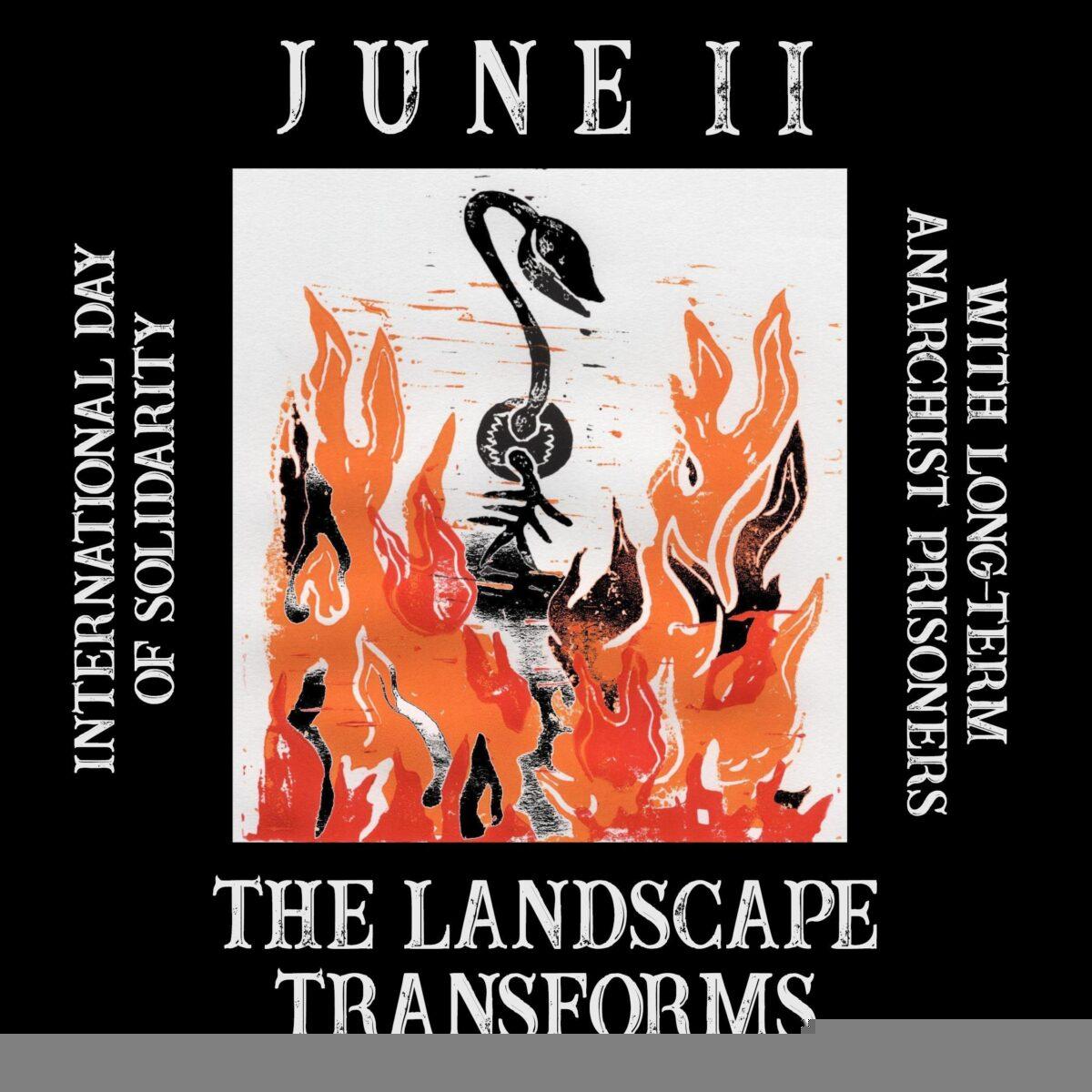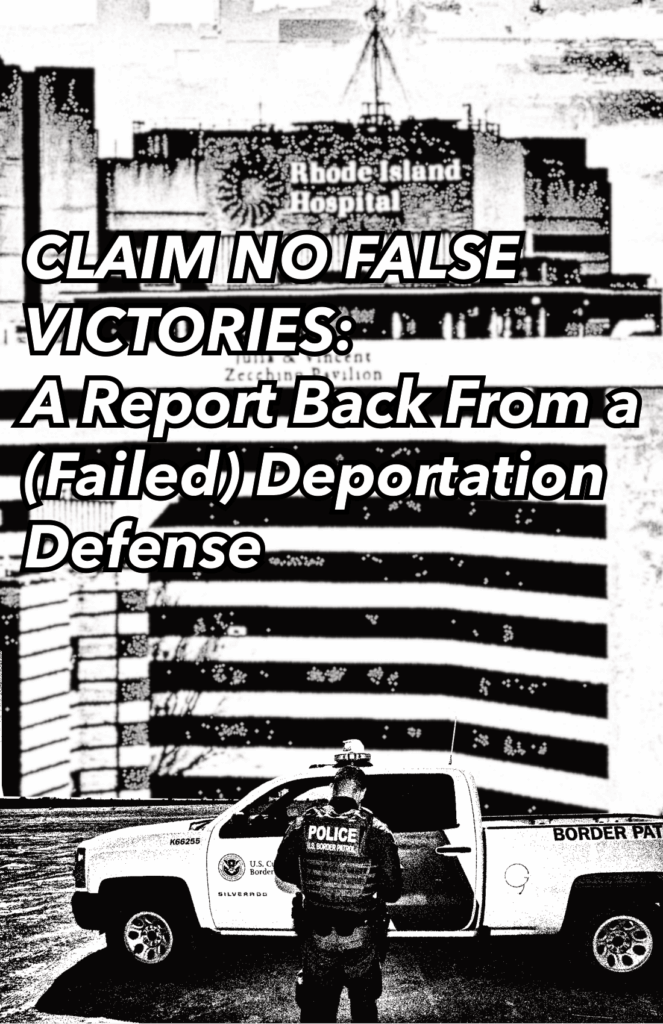
English PDF for screen reading & PDF for printing
Français PDF for screen reading & PDF for printing
Deutsch PDF for screen reading & PDF for printing
Letonă PDF for screen reading & PDF for printing
Svenska PDF for screen reading & PDF for printing
Română PDF for screen reading & PDF for printing
Español PDF for screen reading & PDF for printing
Polski PDF for screen reading & PDF for printing
Português PDF for screen reading & PDF for printing
2025 Call – The Landscape Transforms
Spring is unfolding, and the time has again come to look towards June 11th, the International Day of Solidarity with Marius Mason and Long-term Anarchist prisoners. While our celebration of this day is to lend attention to Marius and other anarchist prisoners at risk of being forgotten because of their long sentences, we’re also continually thinking about how to emphasize how integral prisoners are, and an anti-prison struggle as a whole is, on our path towards freedom.
The site of prison has long held a rebellious and revolutionary potential. Prison is a place for rebels to encounter one another, learn together and organize among themselves. The historical legacy of revolt inside means that the prison of today is even better equipped to manage, isolate and repress rupture. Yet prison, like everything else, is not totalizing in its ability to control or stifle. Despite repression, despite the stultifying effects of things like drugs and institutional violence, prisoners continue to innovate and adapt and those of us on the outside can continue to do the same, in our relationships of solidarity and in our moves toward a world without prisons. This year, we’re struck by a vision of a seed germinated by fire. It waits for the heat and smoke to indicate when the environment is cleared and suitable, to take its chance at life. In a hyper-civilized world that has attempted to eliminate fire in its quest for domination, we must set fire to the old and call forth a birth of new life.
As the terror of this dominant order comes to new, or at least previously obscured heights, we are thinking about how to embolden new paths and relationships alongside terrain that has held potential and embodied revolt since its inception. Our paths will continue to demand experimentation, adaptability, ingenuity. May we be stoked by the dying off of old forces, and enlivened by our readiness for, and taking of, new ways of life!
There is a proud history of anarchists and other radicals meeting up in prison, and a history of them mentoring and teaching others. Black Liberation and adjacent struggles in the US created pockets of radicalization inside prisons, should they be captured, that lead to moments like the Attica Uprising in 1971. Transfers of the long-term recalcitrants lead to meetings of minds like when Sundiata Acoli, Joe Joe Bowen, Hanif Shabazz Bey, and Ray Luc Levasseur met in Marion, Illinois. Joe Joe, for one, continued teaching guerilla strategies long after. Long-term anarchist prisoners have been involved in hunger and work strikes in prisons the world over, notably including many of the Greek comrades, like Nikos Maziotis. The Chilean anarchist, subversive, and Mapuche prisoners collectively pen statements for many days of action, not least of all Mónica Caballero, staying connected to struggles beyond the walls. They also inspire defiance outside of prison, as we see in many actions claimed in solidarity with the comrades aforementioned, and of recent significance: Alredo Cospito’s 180-day hunger strike that, before ending last year, brought about so many incendiary actions. There have also been instances of elders and lifers taking responsibility for mass actions to try to shield others from additional time and consequences.
The state uses prisons to limit and contain rebellious individuals, revolutionary projects, and organizing on the outside. This can sometimes backfire, turning the prison into a hotbed of revolt and radicalization. To adapt to the revolutionary potential of prisoner organizing, modern prisons make use of several tools to control the movement of people, ideas, and skills in an attempt to quash potential revolt. These tools include surveillance – increasingly technological – of individuals, movement, and relationships, and stoking divisions among classes of prisoners, pitting them against each other. Direct physical violence and isolation are used even more liberally on the trouble-makers, advocates, and teachers. In addition to throwing some one in isolation, sometimes for decades, the system also transfers people away from their block, those they trust and organized with, or across the country from their family and supporters. The ongoing expansion of prison systems and facilities is necessary to be able to separate and distance us from each other. Whenever prisoners rise up, the state increases and adapts these measures, and innovates new ones, to prevent it from happening again. All of the barriers we currently face in staying connected and empowered are evidence of just how much the wardens and the managers have to be afraid of.
How, then, do we also adapt to the innovation of tools and techniques of control. First, we must seek to understand them. Often it is the long-term prisoners who can best observe, test, and articulate the behavior of the state, as they have seen it shift over time. This is just one of many reasons why we must actively facilitate their participation in anarchist spaces. So, for us, developing redundant and decentralized ways to stay in communication despite the surveillance and censorship is essential. This is required for us to build inside-outside organizing and collaborations between the imprisoned and the more-free. Correspondence also serves to remind captives that they are not forgotten and their captors that we are watching. Material support is also essential. Money for anarchist prisoners not only helps them get what they need from commissary, but can also flow to others who have less social support. Beyond commissary, funds can also be used in the prison economy to buy or create tools to maintain communication, or for protection from guard or fellow prisoner violence. We must also build the capacity to act in solidarity and in response to what we learn from inside comrades, whether that be in the form of prison demos, phone zaps, destructive acts, and other things few of us have yet dreamt of.
When an anarchist goes to prison, they can serve as a point of connection between people inside and out. Our commitment to and style of doing prisoner support enables this connection to bear fruit, not only for individuals but also, in the best cases, to challenge the power of the state where it is most concentrated. There are many forms this role of anarchist and politicized prisoner can take. They can use their position, voice, and ability to have it amplified, to speak to larger issues. This informs outside comrades on the struggles of captive people. In the U.S., this has best been seen in Black Liberation struggles and overlap between the Black Panther Party and Black Liberation Army activity on the outside, and the uprisings in jails and prisons across the country. More recently, we’ve seen Eric King advocating for friends he made inside who helped him during some of his hardest times. We’ve also seen several people locked up in Atlanta jails for involvement in Stop Cop City and in Pennsylvania for alleged involvement in animal liberation use their media connections to describe conditions inside and to tell the stories of people they met inside. Most people in prison do not have anyone who can proliferate their words, whether through a blog, a zine, or graffiti. Anarchist spaces can and do just that. Michael Kimble is a great example of acting as a conduit between outside support and a captive queer population doing mutual aid on their own terms. Though they are still very precarious and under attack, Marius Mason has been able to strongly influence the treatment of and access for trans people in the federal prison system. In 2020, Jeremy Hammond recorded a video of himself and other captives expressing solidarity with Black Lives Matter protests in the streets. Malik Muhammad writes a column on his blog telling the stories of and doing interviews with people he’s met in segregation. Through his connection to other anarchists, Michael Kimble shares radical Black history on his block during Black History Month and Black August. In these ways, anarchist prisoners tie inside struggle and radicalization to the larger movement outside.
The reverse is also true. By the nature of their position, anarchist prisoners strengthen the larger movement by informing its analysis, methods, and priorities. By their inclusion in the anarchist space, we demystify incarceration and teach each other best practices and survival techniques. This, in turn, empowers others to take necessary risks, knowing they are not alone. Our commitment to supporting our prisoners keeps us honest to our value of confronting state power even where it is most powerful. Maintaining relationships and facilitating the participation in movement space of people who are physically taken from us provides anarchists with a wing of struggle that is “behind enemy lies.” The power to incarcerate, to disappear, to silence, to steal comrades, family, and friends must be contested. And that contestation can only happen with other politicized and revolutionary prisoners. By meeting and struggling together in prison, it strengthens ties between criminalized people and the underclasses: an informal and irregular meeting of enemies of the state.
Our moves towards a life of freedom are undoubtedly shaped and strengthened by struggling alongside those captured by the state. The inventiveness and courage needed to maintain survival and one’s values inside can teach us a great deal about what spirit will need to be mustered as we forge ahead. May this June 11th be a day to reflect on those we love inside, those we grow and struggle with that are locked away, and to make further moves against this world full of prisons and the forces that maintain it.
Prisoner Updates:
Marius Mason is now less than 2 years away from release! Despite the progress he has made for himself and other transgender prisoners, and due to anti-trans policies of the U.S. federal government, in March he was transferred back to a women’s facility in Danbury, Connecticut. The state is also now requiring we deadname Marius in our correspondence. Michael Kimble was also recently transferred to another Alabama facility. He is still working on his resentencing and continues to participate in anarchist publishing. After going on hunger strike because of his property being taken and other harassment, Malik Muhammad was transferred to another facility in Oregon. At this facility, too, he has been targeted and thrown in seg, falsely accused of trying to organize a general strike. Sean Swain continues his collaboration with Final Straw radio. Comrade Z has also worked with Final Straw and written articles for Texas Observer Magazine. Xinachtli has a new fundraising campaign.
Internationally we celebrate that Claudio Lavazza was released from prison last year, after a lifetime in the anarchist struggle. We also note the continued fight of Alfredo Cospito, and now Francisco Solar (in Italy and Chile, respectively), against their particularly heinous conditions. Mónica Caballero continues to organize and speak out from inside the Chilean prisons, and we’ve recently seen some calls for financial support. New repression has also begun in Greece, after an untimely blast in Athens killed one comrade and injured another named Marianna. We stand with all those comrades charged after the explosion. Finally, we added two more anarchists to our list of long-term prisoners, as the Chilean state prepares to prosecute Aldo and Lucas Hernandez – each facing decades in prison, having been held in pretrial detention since December 2022. With each new and continued attempt by the states of the world to enforce obedience to their oppressive programs, we too recognize an urgent desire for their destruction.




